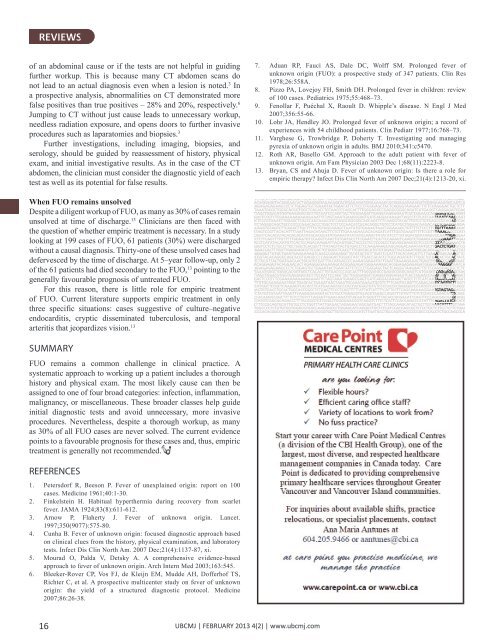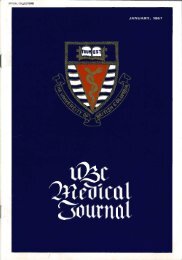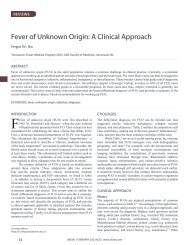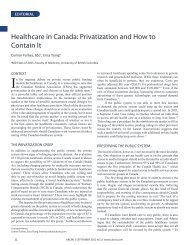Download full PDF - UBC Medical Journal
Download full PDF - UBC Medical Journal
Download full PDF - UBC Medical Journal
Create successful ePaper yourself
Turn your PDF publications into a flip-book with our unique Google optimized e-Paper software.
REVIEWS<br />
of an abdominal cause or if the tests are not helpful in guiding<br />
further workup. This is because many CT abdomen scans do<br />
not lead to an actual diagnosis even when a lesion is noted. 3 In<br />
a prospective analysis, abnormalities on CT demonstrated more<br />
false positives than true positives – 28% and 20%, respectively. 6<br />
Jumping to CT without just cause leads to unnecessary workup,<br />
needless radiation exposure, and opens doors to further invasive<br />
procedures such as laparatomies and biopsies. 3<br />
Further investigations, including imaging, biopsies, and<br />
serology, should be guided by reassessment of history, physical<br />
exam, and initial investigative results. As in the case of the CT<br />
abdomen, the clinician must consider the diagnostic yield of each<br />
test as well as its potential for false results.<br />
7. Aduan RP, Fauci AS, Dale DC, Wolff SM. Prolonged fever of<br />
unknown origin (FUO): a prospective study of 347 patients. Clin Res<br />
1978;26:558A.<br />
8. Pizzo PA, Lovejoy FH, Smith DH. Prolonged fever in children: review<br />
of 100 cases. Pediatrics 1975;55:468–73.<br />
9. Fenollar F, Puéchal X, Raoult D. Whipple’s disease. N Engl J Med<br />
2007;356:55-66.<br />
10. Lohr JA, Hendley JO. Prolonged fever of unknown origin; a record of<br />
experiences with 54 childhood patients. Clin Pediatr 1977;16:768–73.<br />
11. Varghese G, Trowbridge P, Doherty T. Investigating and managing<br />
pyrexia of unknown origin in adults. BMJ 2010;341:c5470.<br />
12. Roth AR, Basello GM. Approach to the adult patient with fever of<br />
unknown origin. Am Fam Physician 2003 Dec 1;68(11):2223-8.<br />
13. Bryan, CS and Ahuja D. Fever of unknown origin: Is there a role for<br />
empiric therapy Infect Dis Clin North Am 2007 Dec;21(4):1213-20, xi.<br />
When FUO remains unsolved<br />
Despite a diligent workup of FUO, as many as 30% of cases remain<br />
unsolved at time of discharge. 13 Clinicians are then faced with<br />
the question of whether empiric treatment is necessary. In a study<br />
looking at 199 cases of FUO, 61 patients (30%) were discharged<br />
without a causal diagnosis. Thirty-one of these unsolved cases had<br />
defervesced by the time of discharge. At 5–year follow-up, only 2<br />
of the 61 patients had died secondary to the FUO, 13 pointing to the<br />
generally favourable prognosis of untreated FUO.<br />
For this reason, there is little role for empiric treatment<br />
of FUO. Current literature supports empiric treatment in only<br />
three specific situations: cases suggestive of culture–negative<br />
endocarditis, cryptic disseminated tuberculosis, and temporal<br />
arteritis that jeopardizes vision. 13<br />
SUMMARY<br />
FUO remains a common challenge in clinical practice. A<br />
systematic approach to working up a patient includes a thorough<br />
history and physical exam. The most likely cause can then be<br />
assigned to one of four broad categories: infection, inflammation,<br />
malignancy, or miscellaneous. These broader classes help guide<br />
initial diagnostic tests and avoid unnecessary, more invasive<br />
procedures. Nevertheless, despite a thorough workup, as many<br />
as 30% of all FUO cases are never solved. The current evidence<br />
points to a favourable prognosis for these cases and, thus, empiric<br />
treatment is generally not recommended.<br />
REFERENCES<br />
1. Petersdorf R, Beeson P. Fever of unexplained origin: report on 100<br />
cases. Medicine 1961;40:1-30.<br />
2. Finkelstein H. Habitual hyperthermia during recovery from scarlet<br />
fever. JAMA 1924;83(8):611-612.<br />
3. Arnow P, Flaherty J. Fever of unknown origin. Lancet.<br />
1997;350(9077):575-80.<br />
4. Cunha B. Fever of unknown origin: focused diagnostic approach based<br />
on clinical clues from the history, physical examination, and laboratory<br />
tests. Infect Dis Clin North Am. 2007 Dec;21(4):1137-87, xi.<br />
5. Mourad O, Palda V, Detsky A. A comprehensive evidence-based<br />
approach to fever of unknown origin. Arch Intern Med 2003;163:545.<br />
6. Bleeker-Rover CP, Vos FJ, de Kleijn EM, Mudde AH, Dofferhof TS,<br />
Richter C, et al. A prospective multicenter study on fever of unknown<br />
origin: the yield of a structured diagnostic protocol. Medicine<br />
2007;86:26-38.<br />
16<br />
<strong>UBC</strong>MJ | FEBRUARY 2013 4(2) | www.ubcmj.com










